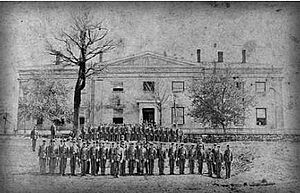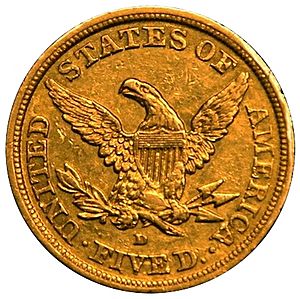Dahlonega Mint facts for kids
The Dahlonega Mint was a special factory that made coins. It was a branch of the United States Mint, which is the official place where the U.S. government makes money. This mint was built during the Georgia Gold Rush. Its job was to help gold miners in Georgia. They could bring their gold here to be tested (called assayed) and turned into coins. This saved them a long trip to the main mint in Philadelphia.
The Dahlonega Mint was located in Dahlonega, Lumpkin County, Georgia. Coins made here have a special "D" mark on them. Today, the "D" mint mark is used by the Denver Mint, which opened much later in 1906. All the coins from the Dahlonega Mint were made of gold. They came in $1, $2.50, $3, and $5 amounts. These coins were made between 1838 and 1861.
Contents
Building the Dahlonega Mint
Why the Mint Was Created
The United States government decided to build new mints in 1835. This decision was made by the United States Congress through a law called the Mint Act of 1835. This law created three new mints. One was in New Orleans for gold and silver coins. Another was in Charlotte just for gold coins. The third was in Dahlonega, Georgia, also only for gold coins.
Construction and First Coins
In August 1835, a man named Ignatius Alphonso Few bought ten acres of land south of Dahlonega. He paid $1,050 for it. He then hired an architect named Benjamin Towns to build the mint. The construction cost $33,450. The building was supposed to be finished in 18 months.
By 1837, the mint had all its machines. These included presses to cut and shape the metal, and a coining press. The coining press was very fast. It could make 50 to 60 gold coins every minute!
The mint officially opened in February 1838. Dr. Joseph Singleton was the first person in charge, called the Superintendent. In the first week, about a thousand ounces of gold were brought in. The very first coins were made on April 17. These were eighty five-dollar gold pieces.
What Coins Were Made?
The Dahlonega Mint made coins every year from 1838 until 1861. They made different kinds of gold coins:
- $1.00 Gold Dollars
- $2.50 Quarter Eagles
- $3.00 Gold Pieces (only made in 1854)
- $5.00 Half Eagles
The Mint During the Civil War
When the American Civil War started in 1861, the Dahlonega Mint was taken over. Soldiers from the Confederate States of America seized control of it. It is believed that the Confederates made some gold dollars and half eagles themselves. They used the mint's machines in 1861.
We don't know exactly how many 1861-D gold dollars were made by the Confederates. However, about 1,597 of the 1861-D half eagles were struck. Because not many coins were made at the Dahlonega Mint, all the gold coins from this mint are quite rare today. It's thought that over $6 million worth of gold coins were made here in total.
After the Civil War
After the Civil War ended, the United States government decided not to reopen the Dahlonega Mint. The building sat empty for a while. Then, in 1873, a new school called North Georgia College was started. The old mint building became the main building for the college. It held classrooms and offices.
Sadly, a fire destroyed the original mint building in December 1878. A new building for the college was built right on the old mint's foundations. This new building is now called Price Memorial Hall. It is named after William P. Price, who founded the college. The college still uses this building today.
You might also see gold from this area in another famous place. Gold leaf from Dahlonega covers the dome of the Georgia State Capitol building in Atlanta. Because of this, people sometimes call the state government's activities what's happening "under the gold dome." After the capitol building got its gold dome, people in Dahlonega wanted to do the same for Price Memorial Hall.
Mint Leaders (Superintendents)
Six different men were in charge of the Dahlonega Mint. They were called Superintendents.
- Joseph Singleton, 1838–1841
- Paul Rossignol, 1841–1843
- James Fairlie Cooper, 1843–1849
- Anderson Redding, 1849–1853
- Julius Patton, 1853–1860
- George Kellogg, 1860–1861
See also



